A new system for wellbore directional control uses continuous drillstring rotation above a positive displacement motor (PDM) and bent sub to combine many advantages of rotary steerable systems (RSS) with proven PDM technology. The new MotarySteerable system offers an economic alternative for rotary well trajectory control in a variety of different drilling conditions. It provides full 3-D directional control while maintaining drillstring rotation to effectively reduce drilling time and mitigate lost-in-hole risk in problematic drilling environments.
Steerable motor assemblies vs. RSS
The overwhelming majority of directional footage drilled today is accomplished with steerable PDMs that use a bent sub and continuous fluid power to apply cross-axis pressure to the rotating bit, enabling it to drill in any direction at some rate of change of trajectory. Alternating between sliding and rotary drilling achieves 3-D wellbore trajectory. PDMs are currently both the most reliable and the most competitively priced options for directional drilling.
Drilling motors have several significant drawbacks compared to rotary steerable tools. They are unable to consistently steer while rotating and unable to drill straight tangent sections. Many newer motors have been designed to drill straighter tangent sections and reduce the need for slow and costly sliding corrections. Adjustable gauge stabilizers (AGS) enable trajectory to be corrected without sliding or bottomhole assembly (BHA) changes. Often, using AGS eliminates most sliding time. However, AGS corrections can take place only in a 2-D plane, up or down. The risk of stuck pipe or loss of BHA increases any time a string is not rotating (i.e. during sliding operations). Finally, because the sliding pipe cannot overcome the frictional forces in the hole, steerable motor assemblies are not applicable for extended-reach wells.
Rotary-steerable drilling enables full, 3-D directional drilling control with continuous drillstring rotation from the surface. Direction and orientation are maintained independent of BHA and drillstring rotation with no stopping or sliding. Two-way pressure- and command-based communications allow trajectory to be adjusted from the surface. Borehole positioning is more precise, and the borehole is smoother, leaving a cleaner, less tortuous borehole with increased reservoir exposure for better completions. RSS can be used to drill complex well trajectories and extended-reach wells. In high rig-cost environments, rotary steerable tools often are preferred over conventional steerable assemblies because of their potential to drill faster.

Operating parameters for the new targeted-bit speed-based directional drilling system are shown in various hole sizes based on a single mud motor type (Hyperline 250). (Images courtesy of Weatherford International Ltd.)
Targeted bit speed
Weatherford International Ltd.’s MotarySteerable system is based on targeted bit speed (TBS), a periodic steering method that applies a repeatable oscillating flow rate to a PDM and bent sub to accomplish continuous trajectory change. The flow rate changes are timed to a specific bent housing toolface and applied continuously to the same angular position of the motor housing as it rotates, allowing the operator to steer the wellbore in any chosen 3-D trajectory. Varia- tions in flow cause slight differences in the axial drilling rate, which, combined with the bent sub, causes the bit to drill further toward the specific target.
Targeted bit speed is similar to periodic sliding of the drillstring with a PDM except that instead of the motor housing stopping or slowing, it rotates continually while the bit speed varies, depending on its angular position in the borehole. The periodic flow is achieved through simple fluctuations within the drillstring generated by a typical MWD positive pulse telemetry device. The pressure pulses are timed to the motor housing’s angular position to effectively manage an oscillating fluid volume entering the motor to precisely vary the bit speed as a function of toolface. TBS enables the motor to cut a disproportionately greater volume of rock from a specific arc segment of the borehole, causing the hole trajectory to follow in the direction of the higher bit speed.
Periodic steering is not new; however, TBS uses this behavior to control trajectory in three dimensions rather than two, which meets criteria for a lower-cost directional drilling alternative to RSS with the benefits of reliable and proven steerable motor and MWD technologies. An additional advantage is that the motor can slide to direct the wellbore if a greater build-up rate is needed than can be generated from targeted bit speed in a given formation and wellbore type.
The system is not a true rotary steerable tool but an improvement on proven technologies to allow full 3-D steering while rotating with a bent housing motor. It produces relatively low build rates while rotating. Build rates tend to be more aggressive in smaller rather than larger hole sizes. To date, the system has been used to drill more than 30,000 m (100,000 ft) of hole in vertical control, low-angle tangent, and lateral sections. It has been run in 6, 7/ 8 , 8 1/ 2 , 9 7/ 8 , and 12 1/ 4 -in. holes.

Using the new directional drilling system in the Eagle Ford shale enabled the operator to beat the previous best-days-vs.-footage-drilled curve while maintaining vertical and tangential control.
Field tests
One of the first field tests of the TBS-based directional drilling system was in the Barnett shale in a horizontal well with a lateral section of approximately 1,990 m (6,500 ft), drilled with water-based mud. After drilling out of surface casing, a short vertical section was drilled, followed by building a 2.5-degree/30-m (100-ft) angle to an 18-degree tangent, dropping 2.5 degrees/100 ft to vertical, then building the curve and lateral. The entire well was drilled using 8 3/ 4 -in. PDC bits and medium speed 6 3/ 4 -in. mud motors. The system drilled more than 3,749 m (12,300 ft) in all sections except the surface hole and landing. Any time the well started to drift, the system’s inclination was reduced, keeping the vertical section from drifting above 2.0 degrees while eliminating slide corrections in the vertical hole. The tangent was maintained, and although the system could not entirely eliminate the need for sliding, it helped reduce it.
In the Eagle Ford shale, the system was used in three wells drilled with oil-based mud using 9 7/ 8 -in. bits and 6 3/ 4 -in. medium speed mud motors and MWD tools. All three wells required a negative nudge with a buildup to a low-angle tangent followed by a drop-back to vertical before changing the BHA to build the curve and horizontal sections. The system was used to drill out of casing, build the negative section, hold the tangent, and then drop to vertical. In the first well, the system provided good vertical control and acceptable build rates from 0 to 4.0 degrees in the targeted azimuth. The inclination was subsequently dropped back to vertical at the end of the tangent section, and 1,341 m (4,400 ft) of hole were drilled. On the second well, vertical control was maintained for the entire 1,634 m (5,360 ft), and inclination was held below 1.0 degree without sliding. On the third well, 2012 m (6,600 ft) were drilled with sliding requiring less than 4% of the time. The vertical sections, both below casing and at the bottom of the well section, were held to less than 1.0 degree inclination with excellent azimuthal control. The run beat the “best days vs. footage drilled curve” for the drilling program and was drilled entirely with the new drilling system.
Recommended Reading
BP: Gimi FLNG Vessel Arrival Marks GTA Project Milestone
2024-02-15 - The BP-operated Greater Tortue Ahmeyim project on the Mauritania and Senegal maritime border is expected to produce 2.3 million tonnes per annum during it’s initial phase.
Orange Basin Serves Up More Light Oil
2024-03-15 - Galp’s Mopane-2X exploration well offshore Namibia found a significant column of hydrocarbons, and the operator is assessing commerciality of the discovery.
Vår Energi Hits Oil with Ringhorne North
2024-04-17 - Vår Energi’s North Sea discovery de-risks drilling prospects in the area and could be tied back to Balder area infrastructure.
Cronos Appraisal Confirms Discovery Offshore Cyprus
2024-02-15 - Eni-operated block partner TotalEnergies says appraisal confirms the presence of significant resources and production potential in the block.
Rystad: More Deepwater Wells to be Drilled in 2024
2024-02-29 - Upstream majors dive into deeper and frontier waters while exploration budgets for 2024 remain flat.





